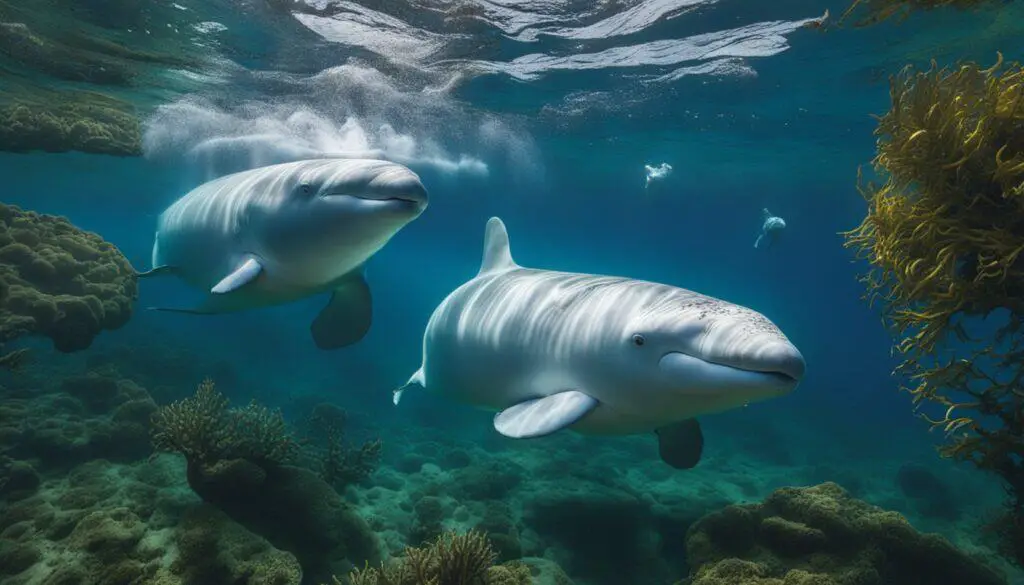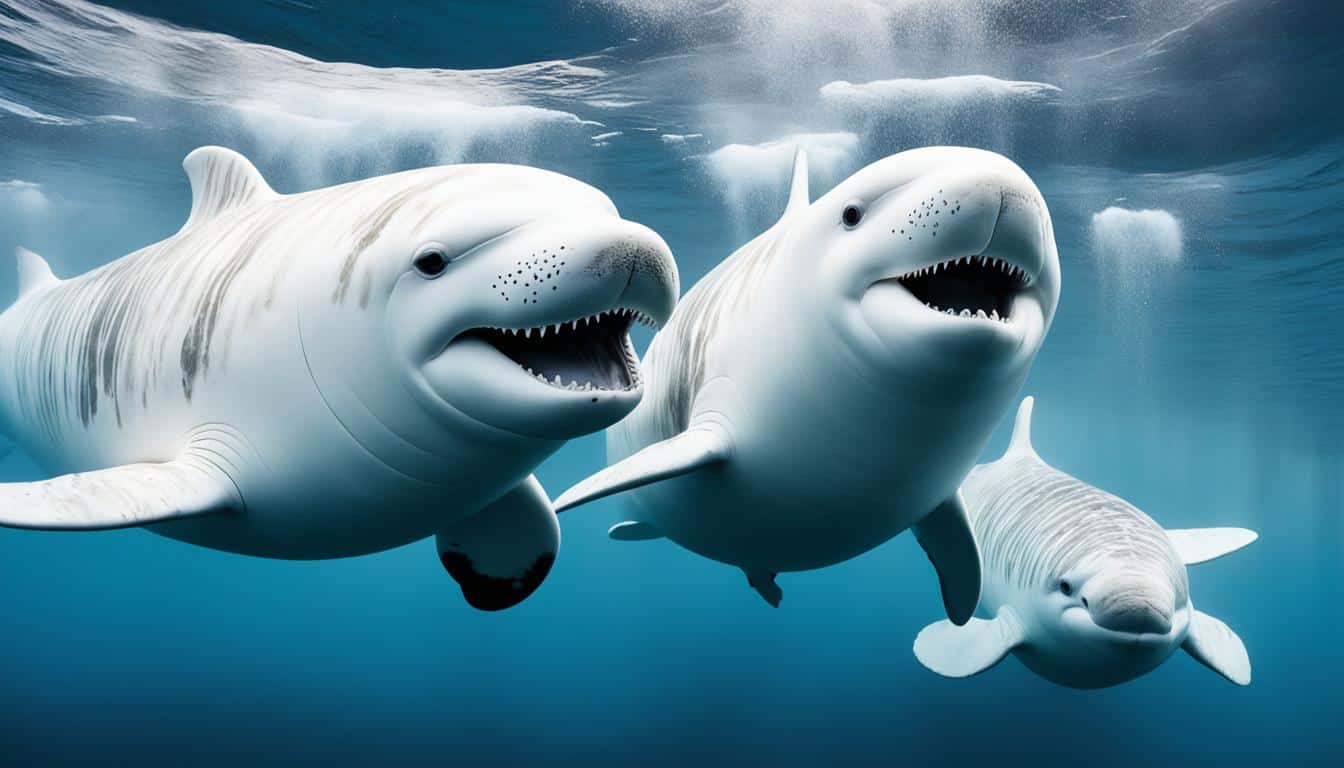Beluga whales, known as the “canaries of the sea,” have a unique way of talking to each other. Their sounds are key to their social life and survival in the Arctic and sub-Arctic. These marine mammals make different sounds for talking, hunting, and finding their way around. Learning about their communication helps us understand their complex social lives and how they adapt to their icy home.
Understanding Beluga Whale Communication
Beluga whales live in groups, from small pods to huge ones with up to a thousand members. They need a strong way to talk to each other to keep their social bonds strong and coordinate group activities. Finding each other in the vast ocean is hard because it’s often hard to see them.
The Social Nature of Beluga Whales
Beluga whales love being around others and have complex relationships in their groups. They hunt together, warn each other of dangers, and help raise their young. This shows they are very smart and have a deep social life.
Importance of Communication in Their Habitat
In the big ocean, being able to communicate is key for beluga whales to survive. They use sounds to warn of predators, guide each other during hunts, and find mates. This shows how important their way of communicating is for their survival.
How do beluga whales communicate?
Beluga whales are known for their amazing way of talking to each other with sounds. They use these sounds to talk and survive in the water. They make many different sounds to send messages and share information. This shows how smart and flexible these whales are.
Vocalizations: The Symphony of Sounds
The beluga whale sounds include high-pitched whistles and trills. Each sound means something different, like how the whale feels or what it’s doing. These sounds work well in the water and air, helping whales talk to each other easily.
Categories of Sounds: Whistles, Calls, and Echolocation
Scientists group beluga whale sounds into three main types:
- Whistles: High-pitched sounds for talking to friends.
- Calls: Different sounds like clucks and trills that share important info.
- Echolocation: Clicks that help whales find their way and hunt.
Echolocation is a key skill for these whales. They use sound waves to understand their world. This helps them hunt in dark, icy waters. With echolocation, they can tell how far away things are, what size they are, and where to find food.
Vocalizations of Beluga Whales
Beluga whales are known for their complex communication. They use a wide range of sounds to talk to each other. These sounds help them connect and survive in their environment. Each sound has a special meaning, making up their unique language.
Types of Vocalizations
Studies show that beluga whales make at least eleven different sounds. These include:
- Resonant whistles
- Squeals
- Chirps
- Bell-like tones
- Clicks
- Growls
- Common calls
- Alarm calls
- Social calls
- Echoed sounds
- Unique pod vocalizations
Each sound has a specific use, like talking to friends, hunting, or warning others of danger. These sounds show how adaptable beluga whales are to their surroundings.
Consistent Patterns Observed in Communication
Beluga whales communicate in predictable ways based on their social life. They make more sounds when they are together. For example, they use alarm calls to warn others of orcas, showing they can quickly respond to threats.
| Vocalization Type | Description | Purpose |
|---|---|---|
| Resonant Whistles | Long, continuous sounds | Used for communication between individuals |
| Squeals | High-pitched sounds | Indicate excitement or social interaction |
| Chirps | Short, sharp sounds | Used in mother-calf interactions |
| Alarm Calls | Intense, loud sounds | Alert others to predators |
Underwater Communication in Beluga Whales
Beluga whales are amazing at talking underwater, using sound for many important tasks. They use echolocation a lot, which helps them find their way and hunt in icy waters.
The Role of Echolocation in Navigation and Hunting
Echolocation is key for belugas. They send out clicks and listen for the echoes to find their way and catch food. This lets them:
- Find prey easily.
- Get around obstacles like underwater things and sea ice.
- Spot breathing holes in ice, which is vital for living in their home.
How Sound Travels in Water
Sound moves much faster in water than in air, about 1.6 km per second. This helps belugas talk to each other underwater. They use sound to find friends, locate food, and stay safe from predators.
This fast sound helps them make a map of their underwater world. So, they hunt better and interact with each other in their complex ocean life.

Social Behavior and Communication Methods of Beluga Whales
Beluga whales show complex social behaviors and use many ways to communicate, not just by making sounds. They use physical contact and visual signals to talk to each other. Actions like jumping out of the water and slapping their pectoral fins are ways they express themselves in their groups.
Belugas mainly talk to each other by making sounds. Their social behavior shows they are smart and can adapt. They are curious and friendly with other sea creatures, even with humans.
Studies have shown belugas are very smart. They can even learn to mimic human speech in some cases. This helps us understand how they communicate, whether in the wild or in places where humans keep them. Seeing how they interact shows why we need to protect their homes and keep their social lives safe from harm.
| Communication Methods | Description |
|---|---|
| Vocalizations | Whistles, clicks, and calls to convey messages. |
| Physical Contact | Body rubs and nudges to establish bonds. |
| Visual Signals | Body language and postures to communicate intentions. |
| Mimicry | Ability to imitate sounds, including human speech. |
Conclusion
Beluga whales have a complex way of communicating with each other. They use sounds and social interactions to connect. Their ability to make complex sounds shows how smart and social they are.
Learning about beluga whale communication is crucial for protecting them. It helps us understand how to keep their homes safe. This is key for their survival.
Belugas use sound to move through the water. This shows how adaptable they are. But, noise pollution and climate change threaten their world. These threats could harm their songs and social lives.
We must protect belugas and their homes for the future. Research and awareness can help keep their oceans safe. Let’s celebrate their unique sounds and social bonds for many years.
FAQ
How do beluga whales communicate with one another?
Beluga whales use a variety of sounds to talk to each other. They make whistles, calls, and use echolocation sounds. These sounds are key for their social life, finding their way, and hunting in the water.
What types of vocalizations do beluga whales produce?
Beluga whales make at least 11 different sounds. These include high-pitched whistles, chirps, and bell-like tones. Each sound has a special purpose, like for social events or warning calls.
Why is communication important for beluga whales?
Communication is crucial for beluga whales. It helps them stay connected in their groups, plan activities together, and warn each other of dangers. This skill is vital for surviving in the tough Arctic and sub-Arctic waters.
How do beluga whales use echolocation in their communication?
Echolocation is a big help for beluga whales. They make clicking sounds that hit objects and then bounce back. This lets them figure out distances and find food, even in murky water.
What role does social behavior play in beluga whale communication?
Beluga whales have complex social lives that need good communication. They work together for hunting and caring for each other. Their many sounds and signals show how smart and adaptable they are.
Can beluga whales mimic human sounds or speech?
Yes, in captivity, beluga whales can copy human speech. This shows their smartness and helps us learn more about how they talk in the wild and in places they live with humans.







